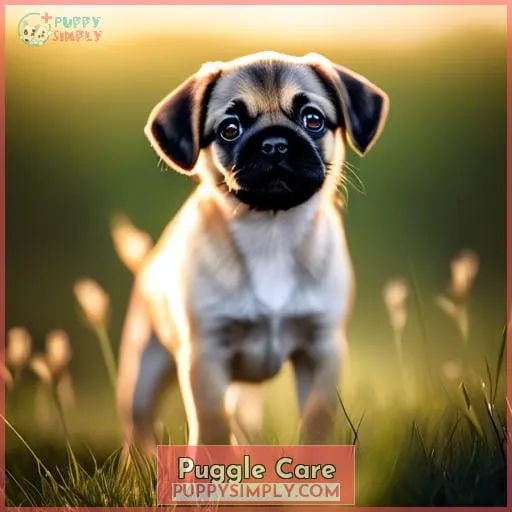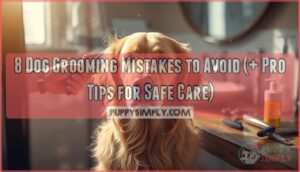This site is supported by our readers. We may earn a commission, at no cost to you, if you purchase through links.
 You’ve stumbled on a little-known secret—the Puggle.
You’ve stumbled on a little-known secret—the Puggle.
Sporting Beagle curiosity and Pug charm, this low-maintenance hybrid brings big personality in a small package.
Peek at pictures revealing their cute mug and tail-wagging gusto.
We’ll sniff out ideal homes, decode their moods, and share inside tips from years of paw practice to keep your Puggle lively and loving life.
Table Of Contents
Key Takeaways
- Friendly, energetic hybrid combining positive traits from both parent breeds like moderate exercise needs and affectionate personalities
- Prone to certain health issues like obesity and require proper nutrition, exercise, grooming, and veterinary care
- Use positive reinforcement when training these intelligent, playful dogs
- Initial and ongoing expenses range from $300 to $1000+ for purchase and $40 to $60 monthly for care
Puggle Overview
Let’s take a closer look at some defining traits of the increasingly popular puggle breed.
We’ll cover details on their physical characteristics and personalities, including common temperament, to help you better understand these spunky pug and beagle mixes.
Getting to know the basics will prepare prospective owners for properly caring for a puggle.
Breed History
Beagle and Pug Mix Breed Pictures, Costs, Care and More:
The Puggle’s origins lie in the accidental crossing of a Pug and a Beagle in the 1980s or 1990s when breeders were experimenting with designer dogs.
- Crossbred origins
- Hybrid vigor
- Breed popularity
The Puggle resulted from accidental breeding of a Pug and Beagle in the 1980s/1990s during the rise of designer dogs.
Despite its random origins, the friendly Puggle grew popular thanks to its playful personality, moderate exercise needs, and cute wrinkled face.
Physical Characteristics
How then do Puggles physically represent this blend of Beagle and Pug ancestry?
You’ll notice both familiar and unique traits when looking at a Puggle.
Their wrinkled, wizened features and large, liquid eyes reflect the Pug side.
Yet their taller, leaner bodies and longer snouts show Beagle influence.
Puggles have hybrid vigor, combining the best physical qualities of both parent breeds for a unique appearance.
Temperament and Personality
Coming from their Beagle and Pug parents, you’re getting a small but playful pup with an affectionate, people-pleasing personality.
Energetic and silly.
Affection-seekers who thrive on human contact.
Intelligent but sometimes stubborn.
With early socialization and positive training techniques, a Puggle’s playful companionship and behavioral quirks can be channeled into a wonderful family dog despite their moderate shedding.
Puggle Care
When owning a Puggle, you’ll need to:
- Stay on top of their grooming needs.
- Give them plenty of exercise.
- Use positive reinforcement during training.
Their short coats shed moderately and require regular brushing.
Puggles have moderate energy levels and do best with:
- At least one long walk per day.
- Indoor play.
Grooming Needs
Having looked at the overview of this charming Beagle and Pug mix breed, let’s dive into their grooming needs for keeping that funny wrinkled face clean as an owner.
You’ll want to brush their short coat a few times a week to control shedding and keep their skin and coat healthy.
Pay attention to cleaning their ears, trimming nails, and bathing only when needed to maintain their skin health.
These Pug mix pictures show just how adorable they can be with proper coat maintenance.
Exercise Requirements
Exercising your puggle daily is essential for their health and happiness.
As they’ve moderate energy levels, some key physical activities include:
- Multiple daily walks.
- Interactive play time with toys.
- Outdoor adventures exploring and sniffing.
- Mental stimulation through training sessions.
Puggles enjoy both physical and mental activities.
Tailor exercise to their play time preferences for a happy, healthy dog.
Training Challenges
Puggles: Beagle and Pug Mix Breed
Pictures, Costs, Care and More
Train your inquisitive Puggle using positive reinforcement. Their stubborn streak requires patience and creativity during training sessions. Keep things fun with food rewards, praise, and play to motivate your Puggle during obedience classes focusing on canine psychology and behavior modification techniques.
Their healthy, loving nature makes Puggles relatively easy to train despite their Beagle and Pug lineage.
Health and Wellness
As a responsible pet owner, you’ll need to stay on top of your Puggle’s health and wellness.
This hybrid can be prone to certain conditions common in Beagles and Pugs, so providing good nutrition and knowing what to look out for is key.
Let’s discuss some of the common health issues Puggles face and how to keep them happy and healthy:
- Obesity: Puggles are prone to obesity, so it’s important to feed them a healthy diet and provide them with plenty of exercise.
- Skin problems: Puggles can also suffer from skin problems, such as allergies and dermatitis. Regular bathing and grooming can help to prevent these problems.
- Eye problems: Puggles can also be prone to eye problems, such as cataracts and glaucoma. Regular checkups with a veterinarian can help to catch these problems early and prevent them from becoming serious.
- Joint problems: Puggles can also be prone to joint problems, such as hip dysplasia and patellar luxation. Providing them with a healthy diet and plenty of exercise can help to prevent these problems.
Common Health Issues
Common health issues your Puggle may face include:
- Breathing problems
- Joint disorders
- Heart conditions
- Eye diseases
Veterinarians can catch these issues early through preventative care like exams and diagnostic tests.
As your Puggle ages, take precautions like:
- Providing optimal nutrition
- Regular exercise
- Alternatives to medications
Partnership with your vet ensures early detection and proper management of any issues for your beagle pug mix’s long-term health.
Diet and Nutrition
When choosing your puggle’s food and determining proper nutrition, you’ll need to consider:
- Their small stature
- Potential for weight gain
Feed balanced diets tailored for small breeds with:
- High-quality proteins
- Digestible carbohydrates
- Healthy fats for energy
Limit treats and overfeeding since puggles easily gain weight.
Stick to pug and beagle nutritional guidelines and adjust for your puggle’s unique:
- Exercise routine
- Life stage
- Health needs
Monitor weight regularly and partner with veterinary guidance for the best lifelong nutrition.
Cost of Ownership
When considering a Puggle puppy, be prepared for both the initial purchase price and ongoing expenses.
The initial cost of a Puggle puppy typically ranges from $300 to $1000.
The lifetime costs of food, supplies, medical care, training, and other expenses will likely total $15,000 to $30,000.
Making an informed budget helps ensure you can provide the proper care over your Puggle’s lifetime.
Initial Purchase Price
You’re looking at around $500 to $1000 initially for a Puggle puppy from a breeder, depending on its pedigree and the breeder’s reputation.
Purchase hesitation is common due to concerns about breed authenticity and the Puggle’s kennel environment before adoption.
However, the mature dog adoption option often costs under $200 and provides an equally loving companion without supporting disreputable breeders.
Ongoing Care Expenses
- They’ll run you between $40 to $60 a month for ongoing care expenses.
- You’re looking at costs for:
- Quality dog food
- Treats
- Toys to keep them mentally stimulated
- Routine vet checkups
- Preventatives like flea and tick medication
- Occasional professional grooming
- Miscellaneous supplies like poop bags and replacement leashes
- Be prepared for potential:
- Veterinary expenses
- Training classes
- Nutritional supplements
- Consider setting up an emergency fund or pet insurance coverage.
Finding a Breeder
When searching for a Puggle breeder, take time to thoroughly vet potential breeders.
An ethical, responsible breeder focuses on breeding healthy, well-socialized puppies over profits. They invest in genetic and veterinary testing for the parent dogs, and breed selectively for ideal temperaments.
Expect transparency from reputable breeders regarding their breeding practices, facilities, and dogs’ pedigrees.
Educate yourself on what constitutes responsible breeding for Puggles specifically. While mixed breeds can be healthier, certain crosses like Boston Terrier Pugs or French Bulldog Pugs risk exaggerating breathing issues.
So choose your breeder carefully. The right one will better ensure your Puggle’s lifelong wellbeing.
Adoption Alternatives
As an alternative to purchasing a puggle, you should consider adopting one from your local animal shelter or rescue organization.
Shelters often have sweet, family-friendly puggle mixes of all ages looking for new homes.
Adopting a shelter puggle can be very rewarding, allowing you to provide a loving home while avoiding some of the health and behavioral issues that may come with poorly-bred designer mixes.
Benefits of Adoption
After finding a breeder, you’d benefit from considering adoption.
Shelters offer charming, healthy puggles longing for homes.
Many shelters have foster programs allowing you to bring home an adorable, rescued puggle while completing the adoption process.
Adopting saves lives and builds families.
Finding Puggles in Shelters
After discussing the benefits of adoption, you’ll want to check shelters and rescue groups upon deciding against buying a puggle from a breeder.
Contact local animal shelters directly to inquire about adoptable puggles or beagle-pug mixes. Shelter staff can guide you through their adoption process and let you know if any puggles are currently available.
Broadening your search area and connecting with pug or beagle rescues may turn up more adoptable puggle options as well.
With some persistence and flexibility, you may find your perfect puggle companion waiting at a shelter.
Living With a Puggle
When bringing a puggle into your home, you’ll want to consider how they’ll get along with any children or other pets.
Puggles tend to thrive when kept as part of the family pack, as their affectionate and playful natures make them wonderful companions for kids.
Proper socialization is key for ensuring your puggle coexists happily with other household pets.
Compatibility With Families
You’ll find puggles to be very compatible with families.
They love bonding with people of all ages and enjoy playing and cuddling.
As affectionate and people-oriented dogs, they thrive when surrounded by their human pack.
Puggles feel most secure when integrated into family life, so plan to involve them in your daily activities.
Require parental supervision during child interactions.
Adapt well to a stimulating home environment with behavioral training.
Family activities provide mental enrichment.
Socialization With Other Pets
When socializing your puggle with other pets, you’ll want to expose them gradually and reward calm interactions.
- Start with brief, positive meetings on neutral territory.
- Separate if fearful or aggressive behavior emerges.
- Initially supervise all interactions.
- Slowly increase contact once acclimated.
Frequently Asked Questions (FAQs)
What is the ideal home environment for a puggle?
As a social and energetic breed, puggles thrive in homes with plenty of activity, interaction, and affection.
They enjoy:
- Being close to their families
- Playing with children and animals
- Going on walks
- Participating in indoor games and training activities
How much exercise does a puggle need every day?
A puggle needs at least one long walk per day to meet their exercise needs.
Additional indoor play and training sessions will also help expend their moderate energy levels.
Monitor your puggle’s weight and activity to ensure they’re getting adequate exercise without overdoing it.
What kinds of games and toys do puggles enjoy?
Seek out interactive toys that allow them to use their natural curiosity and intelligence.
Food puzzles, treat balls, rope toys, and soft squeaky toys will delight their playful spirits and strengthen your bond through playtime joy.
What training methods work best for puggles?
When training puggles:
- Use positive reinforcement like treats and praise.
- Be consistent with commands and routines.
- Keep sessions short and fun with varied activities to hold their interest.
Patience is key – puggles can be stubborn.
Make training feel like a game, not a chore.
Stay calm, yet firm when correcting behaviors.
What are some common mixed breed health issues I should look out for?
When adopting any mixed breed, research potential health issues from both parent breeds.
Beagles may pass on issues like glaucoma or hypothyroidism.
Pugs often have breathing difficulties, hip dysplasia, or allergies.
Mixes like Puggles can inherit those.
Thoroughly vet breeders, ask questions, and get to know the parents’ medical history to ensure your new pup stays happy and healthy.
Conclusion
At the end of the leash, the plucky Puggle brings bushels of beagle inquisitiveness blended with pint-sized pug charm.
Their small stature and moderate needs make them fine apartment pups, yet don’t let size fool ya—they pack plenty of devoted companion moxie.
With proper socialization and early positive experiences, you’ll soon be sniffin’ out fun adventures together.
Ultimately, the Puggle’s winning personality and moderate care requirements offer an appealing package for many.













